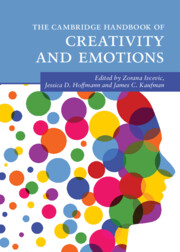Book contents
- The Cambridge Handbook of Creativity and Emotions
- Cambridge Handbooks in Psychology
- The Cambridge Handbook of Creativity and Emotions
- Copyright page
- Dedications
- Contents
- Figures
- Tables
- Contributors
- Acknowledgments
- Creativity and Emotions
- Part I Methods in the Study of Creativity and Emotions
- Part II The Development of Creativity
- Part III Emotions and the Creative Person
- Part IV Emotions and Creative Products
- Part V Emotions and Creativity at School and Work
- 24 Anxiety, Fear of Failure, and Creativity
- 25 Peers, Affect, and Creativity at School
- 26 Creative Curricular Experiences
- 27 Organizational Affective Climate and Creativity at Work
- 28 Group Affect and Creativity
- 29 Psychological Safety and Creativity
- 30 Leadership, Creativity, and Emotions
- 31 A Multilevel Model of Emotions and Creativity in Organizations
- 32 Creativity and Emotion
- Index
- References
27 - Organizational Affective Climate and Creativity at Work
from Part V - Emotions and Creativity at School and Work
Published online by Cambridge University Press: 16 February 2023
- The Cambridge Handbook of Creativity and Emotions
- Cambridge Handbooks in Psychology
- The Cambridge Handbook of Creativity and Emotions
- Copyright page
- Dedications
- Contents
- Figures
- Tables
- Contributors
- Acknowledgments
- Creativity and Emotions
- Part I Methods in the Study of Creativity and Emotions
- Part II The Development of Creativity
- Part III Emotions and the Creative Person
- Part IV Emotions and Creative Products
- Part V Emotions and Creativity at School and Work
- 24 Anxiety, Fear of Failure, and Creativity
- 25 Peers, Affect, and Creativity at School
- 26 Creative Curricular Experiences
- 27 Organizational Affective Climate and Creativity at Work
- 28 Group Affect and Creativity
- 29 Psychological Safety and Creativity
- 30 Leadership, Creativity, and Emotions
- 31 A Multilevel Model of Emotions and Creativity in Organizations
- 32 Creativity and Emotion
- Index
- References
Summary
While researchers have established that affective states play a large role in individual creativity, the relationship between affect and collective creativity is not well understood. This oversight is meaningful as, particularly in organizations, creativity is often the result of collective action. We review and integrate work on how positive and negative affective climate and discrete emotional climates impact creativity at work. Then, we propose a new definition of affective climate and four future directions for the field. First, higher-level affective states should be treated as more than manifestations of their individual-level analogs. Second, a focus on shared homogenous affect has precluded work on more complex, heterogeneous affective climates, which future work should study. Third, there is a lack of work on top-down drivers of collective affect, partially produced by a lack of work on collective affect at levels higher than the team. Fourth, more work on discrete collective affect, including social emotional climates (e.g., love, pride, envy), is needed since such work allows for the development of higher-level theory based on social perceptions, relationships, and interactions. We hope our review helps researchers address these gaps and produce a more nuanced understanding of how affective climate influences collective creativity.
Keywords
- Type
- Chapter
- Information
- The Cambridge Handbook of Creativity and Emotions , pp. 521 - 539Publisher: Cambridge University PressPrint publication year: 2023
References
- 1
- Cited by

